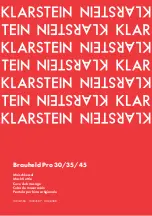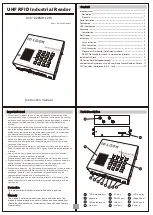
8
DO NOT USE THE POWER UNIT TO EXTEND THE CYLINDER
Make sure both parts on the cylinder are open to allow the easy flow of air.
Manually or with a device such as a come along, pull the cylinder out 60 inches.
Although the cylinder may be difficult to move at first, it is usually much easier
once you get the first movement.
If you have a compressor you can use air to extend the cylinder. Place the air
Into the back port, (the port away from the chrome rod) and blow air into the
cylinder.
After you have extended the chrome rod attach the cable to the top caps in the
legs. Make sure each cable is on the pulleys. Place both nuts on top of the top
cap and tighten them together.
Safety Latch Linkage Installation:
Locate and identify the components needed
to install the safety latch linkage rods. Install the spacers from on the straight
threaded end of the
1/2” x 50” (1/2” x 70” for the XLT) bent rod
and the
threaded end of the
1/2” x 126” straight safety latch linkage rod.
Install the
1/2” x 50” (70” XLT) bent safety latch linkage rod
into the main side
track adjacent to back end of the cylinder (opposite the cylinder rod). Safety latch
linkage rod should pass through guide tubes on underside of track.
Install the
1/2” x 126” straight safety latch linkage rod
into the main side track
from the opposite end. The rod should pass through two guides on the underside
of the main side track.
Attach the
71” hose
to the fitting on the power unit. Attach the other end of the
71” hose
to outside fitting in main side track. Attach hose from cylinder to track
fitting.
Place a funnel into vent cap hole and fill the tank with one of the following fluids:
AW-32
or
ISO-32
hydraulic oil.
Mobile DTE 24, or Texaco HD 32 DO NOT USE
DEXRON
®
IN THIS LIFT!
This tank will hold approximately 12 quarts.
Relocating or changing components may cause problems. Each component in
the system must be compatible; an undersized or restricted line will cause a drop
in pressure. All valve, pump, and hose connections should be sealed and/or
capped until just before use. All parts should be supplied from manufacture. Air
hoses can be used to clean fittings and other components. However, the air
supply must be filtered and dry to prevent contamination.
Most important -
cleanliness
- contamination is the most frequent cause of malfunction or failure
of hydraulic equipment.
Summary of Contents for NSS-8000
Page 1: ...NSS 8000 Installation Manual ...
Page 11: ...11 ...
Page 12: ...12 ...
Page 13: ...13 ...































